Mary Anne Yarde's Blog: The Coffee Pot Book Club , page 110
December 17, 2019
#BookReview — Immortal Defiance (Dulcea’s Rebellion #1) by Laura Maybrooke #HistoricalFantasy #MustRead @LMaybrooke
 Immortal Defiance(Dulcea’s Rebellion #1)By Laura Maybrooke
Immortal Defiance(Dulcea’s Rebellion #1)By Laura Maybrooke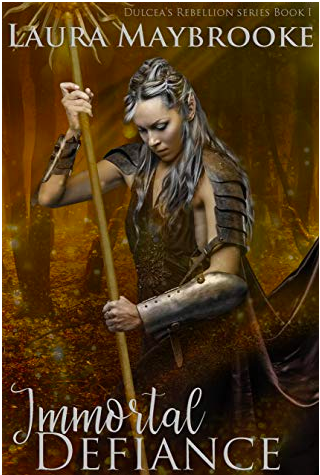
Some things never die. Hope. Heroes. Defiance.
Things take a strange turn for Dulcea, the elven enchantress turned war heroine and Dragonmistress, when a countryman's betrayal lands her in enemy hands.
As she awaits her execution, a stranger with mysterious powers offers her another chance at life. Will she die here or risk what sinister fate he has in store for her?
Can Dulcea reclaim her rightful place and lead her army once more? Or does Krath, the man who travels the Realm of the Dead as one of its own, prove to be the obstacle that fells her rebellion?
… Or will this immortal vampire warrior turn out to be the best chance she has of defying the ancient evil arising in the west?

“Would you like to take your chances with me... or with them?”
Considering Neros, the high priest, wants to sacrifice Dulcea “Lightbringer” Silanquel to Asherac so that she may serve until the end of time as the Dark God’s handmaiden, there did not seem to be that much of a choice. But Dulcea knows nothing about her would-be rescuer. She can only hope that he is the lesser of two evils.
Krath, Lord of Gwyndoorn, has walked this earth for over a thousand years. He has seen kingdoms rise and fall. He has seen loved ones murdered. He has seen too many battlefields — too many wars. He has seen far too much. However, there is something about Dulcea that awakens his curiosity. Dulcea is fighting a war that Krath knows she cannot win. The evil that is rising in the west cannot be vanquished. And yet, Dulcea’s courage and determination draw Krath inexplicably towards her.
Dulcea knows she should fear Krath. He could take her life in an instant, or worse, turn her into a willing slave with his mind-control tricks, but he does neither, and Dulcea does not know what to make of him. Krath’s unfailing honestly with her also makes it incredibly difficult for Dulcea not to like him. Kraft is turning everything she thought she knew of his kind on its head. However, with a traitor in her ranks, Dulcea must keep her friends close, and her enemies closer. Only time will tell which one of those Krath is...
From a terrifying abduction to the discovery of the true identity of the Black Dragonlord, Immortal Defiance (Dulcea’s Rebellion #1) by Laura Maybrooke is a book that is both masterful and enchanting. This is what historical fantasy is all about.
Maybrooke has laid a solid foundation for what promises to be the next great epic historical fantasy series. With elves, dragons, humans, and let’s not forget a dashingly handsome vampire, Immortal Defiance is a fantastic romp through a fantasy world torn asunder by war. This book had all the feels, from the wonderfully depicted magical world to the charismatic protagonists and the evil antagonists.
With a rich narrative, which reminded me of J.R.R. Tolkien’s Lord of the Rings, and an almost lyrical quality to the prose, Immortal Defiance has a lot to recommend it. Here is a book that is filled to overflowing with imagination and it has an energy that threatens to mesmerise. This was an enthralling tale that grabbed me from the first sentence and did not let go until that final full stop. It is an irresistible book, so irresistible that I could not put it down. In fact, I read it in one sitting.
There are a lot of flashbacks in this book, which I found endlessly fascinating. They did not interfere with the story in any way, but instead, they enhanced it, giving readers a little more insight into what had happened. It was a bold choice by Maybrooke to do this, as sometimes a lot of flashbacks get in the way of the actual story the author is trying to tell, but in this case, I think Maybrooke pulled it off rather spectacularly. Kudos, Ms Maybrooke.
I adored the characterisation of Dulcea. Dulcea is an elven enchantress, Dragonmistress, and leader of elves. She is determined to bring her people freedom no matter what the cost. But she is also young and idealistic. Dulcea is a strong heroine who knows what she wants and is determined to find a way to achieve it. She is intelligent, canny and yet she is willing to listen to her advisors, even if she does not always like what they have to say. I thought her relationship with Myoden was, at times very sweet, yet it was her growing feelings towards Krath that really drove this story forward. At first, she fears Krath — who wouldn’t be fearful of someone who could use the Netherworld to travel over vast distances within seconds? By the end of this novel, Dulcea’s feelings towards Krath change. He becomes a confidant, a friend, and there are hints that one day their relationship will be of a romantic nature. I hope so, anyway!
Like Dulcea, I was a little unsure of Krath at the beginning of this novel. He is a creature of darkness, but he doesn’t give in to this darker evil side, and he has his emotions firmly under control at all times, which made him sometimes difficult to get a handle on, which I think is what Maybrooke intended. Is he a friend, or is he a foe? Is Dulcea going to survive her encounter with him and come out unscathed, or will she end up like his other devoted servants who are content to live their lives under his mind-control powers? I think this made Krath an endlessly fascinating character and for me, it was Krath’s depiction that closed the deal on this book. I thought his characterisation was brilliant and I cannot wait to read more about him in Book #2.
If you are looking for your next great historical fantasy where the romance is tender, and the magical realm is spectacular, then look no further than Immortal Defiance (Dulcea’s Rebellion #1) by Laura Maybrooke. I, for one, cannot wait to get my hands on book #2.
I Highly Recommend.
Review by Mary Anne Yarde.The Coffee Pot Book Club.
Pick up your copy ofImmortal DefianceAmazon UK • Amazon US
Laura Maybrooke
 "I live in my own little world. But it's ok, they know me here." (Who besides me has this fridge magnet; raise your hand!)
"I live in my own little world. But it's ok, they know me here." (Who besides me has this fridge magnet; raise your hand!)That's sometimes what it feels like. Who says stories aren't real? I live in the land of the Midnight Sun and Polar Nights, together with my husband and daughter, and a cast of fantasy characters running around in my head. It's busy here. Care to stay and chat a while?
Laura Maybrooke is an 80s' child, who works too much and writes too little, but who'll never say no to a thrilling romance, a high fantasy adventure, or a cookbook full of delicious treats she'd like to bake one day.
Connect with Laura: Website • Facebook• Twitter • Pinterest.
Published on December 17, 2019 21:00
Christmas in the time of the Vikings by Mercedes Rochelle #Christmas #History #Vikings @authorrochelle

Christmas in the time of the
VikingsBy Mercedes Rochelle
Yule celebrations are Pagan in origin and came from the Germanic countries. They were alive and well in the Nordic lands, and were most likely brought over to Anglo-Saxon England with the Viking settlers. Eventually, the midwinter celebrations merged with the Christian festival of Christmastide, better known as the 12 Days of Christmas. I think we would recognize many of their festivities, although some of them were dedicated to Odin!
Since the Yule (or Jul) took place around the Solstice, the shortest day of the year, there is a certain element of celebrating the return of the light. It is said that the name Yule is derived from the Old Norse HJOL, meaning ‘wheel,’ to identify the moment when the wheel of the year is at its lowest point, ready to rise again. But it was also thought that in this time of year, the spirits of the dead most commonly crossed over into the human realm. It is thought that many of the Yuletide customs were an attempt to protect the household against hostile supernatural influences. On the other hand, it is also said that ancestors came back during this season, and sometimes food was left out for them so they would help promote a good harvest the following year. Some of the spirits were benevolent—but not all.
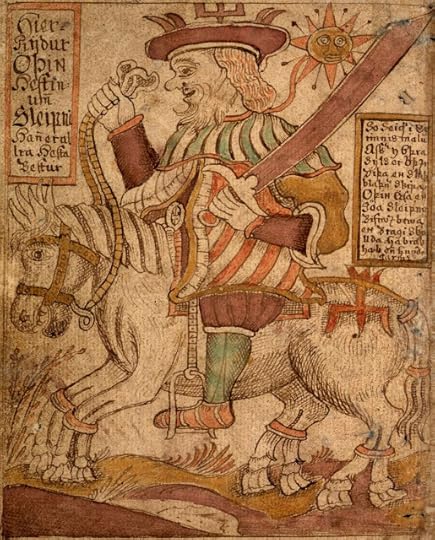 Odin riding Sleipnir. From the 18th century Icelandic manuscript. Source, Wikipedia.
Odin riding Sleipnir. From the 18th century Icelandic manuscript. Source, Wikipedia.One night stood out from the others—the 24thof December. This is when the children filled their shoes with straw, carrots and sugar lumps and set them out by the fire to feed Odin's flying eight-legged horse Sleipnir as the God led the Wild Hunt—the host of the restless dead—through the darkness. In return, Odin would leave the children small gifts and sweets as a reward. He was even known to slide down the chimney! Or fire hole, as the case may be.
Many tales were told of the Wild Hunt. Because winter nights were often stormy and turbulent, Odin was most likely to be heard then, raging and howling, riding to collect the fallen, whether they be living or recently departed. People—especially children—were warned to stay indoors. It was a terrible thing to witness the Wild Hunt; rumors abounded that people seeing the Wild Hunt might be abducted to the underworld or to the fairy kingdom—or even killed. A gift—or rather, a sacrifice—was advised, to thank Odin for taking care of the family’s recently deceased. In 1673, Johannes Scheffer (The History of Lapland) wrote “All the Bits they have preserved for these two Days, they put in a small Chest made of the Bark of Birch, in the shape of a Boat, with its Sails and Oars; they pour also some of the Fat of the Broth upon it, and thus hang it on a Tree, about a Bow Shot distant from the backside of their Huts”. Perhaps this represented the practice of ship burials, though no one really knows the exact purpose of this ritual.
 The Wild Hunt by Johan Wilhelm Cordes, Museum Behnhaus Drägerhaus, Lubeck, Germany (Source, Wikipedia).
The Wild Hunt by Johan Wilhelm Cordes, Museum Behnhaus Drägerhaus, Lubeck, Germany (Source, Wikipedia).Yule is a time for feasting, dancing, and family. The traditional food of the Yule was Boar, an animal sacred to Freyr, the Norse God of Yule and fertility. This was probably the origin of the Boar's Head presented at later Christmas feasts. Then we have the Yule Log. The largest ash—the wood of Yggdrasil—log was brought inside so that ritual runes could be carved onto it, calling on the gods to protect one and all from ill-fortune. Burning the Yule log was thought to give power to the sun and bring warmth again to the land. The carved log was sprinkled with mead and decorated with dry sprigs of pine and cones and as it was lit, musicians plucked the strings of their harps and started the singing. It burned for twelve hours, which brought good fortune for the next twelve months.
Outside, evergreens would be decorated with small lanterns and candles, plus crackers, little carved statues of gods, pieces of dried fruit, and even berries strung together. A huge bonfire was lit, reportedly to dispel any evil that was marching abroad. There was dancing around and through the bonfire, especially among the youngsters.
 Odin the Wanderer, by Georg von Rosen, 1886 from the Swedish Poetic Edda (Source, Wikipedia).
Odin the Wanderer, by Georg von Rosen, 1886 from the Swedish Poetic Edda (Source, Wikipedia).It’s pretty commonly assumed that Odin the Wanderer eventually morphed into our Santa Claus. The old legends came in many forms, one of which was Odin on a chariot pulled by goats (who later became reindeers). Or, possibly, his eight-legged Sleipnir was the precursor to reindeer (naturally, from the North). Odin who was the lord of Alfheim, the home of the elves (Santa’s elves?). The comparisons go on and on. How much of is true?
FROM GODWINE KINGMAKER
Canute was relatively quiet during the festivities, and Godwine spent many hours by his side observing the drinking and dancing; the feasting was excellent and their seats overlooked everything. Most of the others kept their distance from the King, but Godwine felt no such compunction. Canute seemed to appreciate his company.
“I think this is the last time I will take part in the old celebrations,” Canute said, running his finger along the carved dragon head on his chair arm. “It does not sit well with the Christian traditions.” Nonetheless, the King allowed himself a sly smile. “Of course, perhaps we can introduce a few Norse traditions to the English, eh?” He rubbed his hands together. “But I yearn to go back. England feels more like home now, and I would see my wife and child.”

Harold Godwineson, the Last Anglo-Saxon King, owed everything to his father. Who was this Godwine, first Earl of Wessex and known as the Kingmaker? Was he an unscrupulous schemer, using King and Witan to gain power? Or was he the greatest of all Saxon Earls, protector of the English against the hated Normans? The answer depends on who you ask. He was befriended by the Danes, raised up by Canute the Great, given an Earldom and a wife from the highest Danish ranks. He sired nine children, among them four Earls, a Queen and a future King. Along with his power came a struggle to keep his enemies at bay, and Godwine's best efforts were brought down by the misdeeds of his eldest son Swegn. Although he became father-in-law to a reluctant Edward the Confessor, his fortunes dwindled as the Normans gained prominence at court. Driven into exile, Godwine regathered his forces and came back even stronger, only to discover that his second son Harold was destined to surpass him in renown and glory.
Pick up your copy ofGodwine Kingmaker Amazon UK • Amazon US
Mercedes Rochelle
 Mercedes Rochelle is an ardent lover of medieval history, and has channeled this interest into fiction writing. She believes that good Historical Fiction, or Faction as it's coming to be known, is an excellent way to introduce the subject to curious readers. Her first four books cover eleventh-century Britain and events surrounding the Norman Conquest of England. Her new project is called “The Plantagenet Legacy” and begins with the reign of Richard II. She also writes a blog: HistoricalBritainBlog.com to explore the history behind the story. Born in St. Louis, MO, she received by BA in Literature at the Univ. of Missouri St.Louis in 1979 then moved to New York in 1982 while in her mid-20s to "see the world". The search hasn't ended! Today she lives in Sergeantsville, NJ with her husband in a log home they had built themselves. Connect with Mercedes: Website • Blog • Facebook • Twitter.
Mercedes Rochelle is an ardent lover of medieval history, and has channeled this interest into fiction writing. She believes that good Historical Fiction, or Faction as it's coming to be known, is an excellent way to introduce the subject to curious readers. Her first four books cover eleventh-century Britain and events surrounding the Norman Conquest of England. Her new project is called “The Plantagenet Legacy” and begins with the reign of Richard II. She also writes a blog: HistoricalBritainBlog.com to explore the history behind the story. Born in St. Louis, MO, she received by BA in Literature at the Univ. of Missouri St.Louis in 1979 then moved to New York in 1982 while in her mid-20s to "see the world". The search hasn't ended! Today she lives in Sergeantsville, NJ with her husband in a log home they had built themselves. Connect with Mercedes: Website • Blog • Facebook • Twitter.
Published on December 17, 2019 20:00
December 16, 2019
#BookReview — Amulet’s Rapture (Curse of Clansmen and Kings #3) by Linnea Tanner #HistoricalFantasy #AncientRome @linneatanner
 Amulet’s Rapture(Curse of Clansmen and Kings #3)By Linnea Tanner
Amulet’s Rapture(Curse of Clansmen and Kings #3)By Linnea Tanner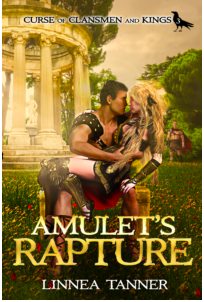
Blood stains her Celtic home and kingdom. The warrior Druid princess will do anything to retake her throne.
Although Catrin is the rightful heir to the Celtic throne in Britannia, she is lucky to be alive. After witnessing the slaughter of her family at the hands of her half-brother, who was aided by the Romans, she is enslaved by a Roman commander. He disguises her as a boy in the Roman Legion with the belief that she is an oracle of Apollo and can foretell his future. The sole bright spot in her miserable new life is her forbidden lover Marcellus, the great-grandson of the famed Roman general Mark Antony.
But Marcellus has been wounded and his memories of Catrin and their secret marriage were erased by a dark Druidess. Though Marcellus reunites with Catrin in Gaul and becomes her ally as she struggles to survive the brutality of her Roman master, he questions the legitimacy of their marriage and hesitates to help her escape and retake her kingdom. If their forbidden love and alliance are discovered, her dreams of returning to her Celtic home with Marcellus will be shattered.

“Did Apollo send that raven to curse me? Did a Roman priest train you to be a warrior priestess?”
If that was what Tribune Decimus Flavius, Catrin’s Roman master, believed, then who was she to contradict him? And if it kept her alive, then that can only be a good thing, although sometimes it did not feel like that for her family had been slaughtered, and her Roman husband has no memory of her.
Marcellus, the great-grandson of the famed Roman general Mark Antony, left Britannia with no memory of his time there and a stomach wound that continued to fester. He seeks comfort in the arms of a former lover, looking for something familiar, something he can hold on to. But even Eliana’s touch does not settle his troubled mind. Unfortunately, it makes his situation far more precarious, for Eliana is married to another man.
Disguised as a boy and forced to train with the men, Catrin must hide who she is from everyone, but especially from Decimus. For if he knew what she could really do, the consequences do not bear thinking about.
From the soft autumn days of Northern Gaul to a Gladiator arena, Amulet’s Rapture (Curse of Clansmen and Kings #3) by Linnea Tanner is a majestic work of scholarship.
Tanner has carefully woven history with fantasy to create a beautifully told tale that is populated with characters that are worth caring about and are deserving of your time. Filled to bursting with romance, magic, love, hate, betrayal and adventure, Amulet’s Rapture is a story that is next to impossible to put down. I read it in one sitting — there was no way I could tear myself away from these characters and this novel.
The heroine of this story is young Catrin. Catrin was a royal princess and heir to the throne of Brittania, but now she finds herself a slave to Tribune Decimus Flavius. Disguised as a boy to keep her safe, Catrin faces one ordeal after another. Yet her strength of character and her unbreakable Celtic spirit sees her through some very dark days indeed. Her ability to love is tempered only by the realisation that she has been abandoned and must face a bleak future where the only escape would be death. I absolutely adored Catrin. Her portrayal was magnificent. She is a very strong young woman, who has seen unimaginable horrors, and yet her heart is full to bursting with love for Marcellus. Her passion for him burns as brightly as she does. But there is another side to Catrin, she is not just an enslaved princess she is also a raven spirit, and she can manipulate the Wall of Lives —a transitional barrier between the mortal world and the Otherworld. Decimus believes her to be an oracle of Apollo, which she isn’t, but she is indeed quite magical and can shapeshift into a beloved raven. I enjoyed reading about Catrin very much, there was a realism to her characterisation that was tangible.
Oh, Marcellus, where do I begin? Marcellus is, as is expected of a male protagonist in a romantic setting, everything he should be. He is driven to distraction by his love for Catrin, and even though he has no memory of her, his soul is incapable of forgetting — how romantic is that? And because of this, he cannot stay away from her. The consequences of his actions not only for himself but also for Catrin, are catastrophic. However, Marcellus is young and passionate, and so full of gentle grace that it is impossible not to like him. He does put Catrin into danger, but not with intention. He isn’t a bad man, and he does try to atone, but his world and Catrin’s don’t belong together, which is heartbreakingly evident throughout this story. Having not read the other books in this series, I can only surmise that their relationship in Britannia was as passionately consuming as it is in Gaul. Marcellus is a character that I cannot wait to read more about.
There are as several antagonists in this story. The first antagonist is Tribune Decimus Flavius. He may well have saved Catrin's life in Britannia, but his treatment of her is diabolical. He uses her for his own means, and when she has ceased to be useful, he means to destroy her. He is an incredibly manipulative and cold man who I did not take to at all. By the end of the book, I despised him. The other antagonist is Marrock, who is utterly deplorable and incredibly dangerous. His greed for power has seemingly no end — the only one who has any chance of stopping him is Catrin, but because of her situation, there is nothing she can do.
Tanner pens a compelling narrative, and she writes with imagination and a great deal of energy. This is a book that is triumphant in all ways. If you are looking for your next great historical fantasy series set within a realistic Roman backdrop, then look no further than Amulet’s Rapture (Curse of Clansmen and Kings #3) by Linnea Tanner. Fans of Jez Butterworth's Britannia will fall in love with this book.
I Highly Recommend.
Review by Mary Anne Yarde.The Coffee Pot Book Club.
Pick up your copy ofAmulet’s RaptureAmazon UK • Amazon US
Linnea Tanner
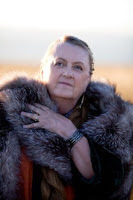 Linnea Tanner weaves Celtic tales of love, magic, adventure, betrayal and intrigue into historical fiction set in Ancient Rome and Britannia. Since childhood, she has passionately read about ancient civilizations and mythology which held women in higher esteem. Of particular interest are the enigmatic Celts who were reputed as fierce warriors and mystical Druids.
Linnea Tanner weaves Celtic tales of love, magic, adventure, betrayal and intrigue into historical fiction set in Ancient Rome and Britannia. Since childhood, she has passionately read about ancient civilizations and mythology which held women in higher esteem. Of particular interest are the enigmatic Celts who were reputed as fierce warriors and mystical Druids.Depending on the time of day and season of the year, you will find her exploring and researching ancient and medieval history, mythology and archaeology to support her writing. As the author of the Apollo’s Raven series, she has extensively researched and traveled to sites described within each book.
A native of Colorado, Linnea attended the University of Colorado and earned both her bachelor’s and master’s degrees in chemistry. She lives in Windsor with her husband and has two children and six grandchildren.
Connect with Linnea: Website Blog Twitter Amazon Author Page Facebook Linked-in Pinterest Google Goodreads
Published on December 16, 2019 21:00
Saturnalia: Pagan Rome’s Jolly Holiday by Brook Allen #History #AncientRome #Saturnalia @1BrookAllen
 Saturnalia: Pagan Rome’s
Saturnalia: Pagan Rome’sJolly HolidayBy Brook Allen
As much as I love Christmas, my novels are set in pre-Christian Rome. So much for wishing Marc Antony a Merry Christmas! But Romans had plenty of festivals—times of celebrations, visiting temples, and making religious sacrifices. And sometimes, their festivals had nothing to do with religion at all, but honored birthdays, triumphs, or other ostentatious celebrations. So what exactly did the Romans celebrate during the month of December? In a useful compilation of facts on Roman life, compiled by Lesley and Roy A. Adkins, the Handbook to Life in Ancient Rome includes a fantastic listing of festivals celebrated annually by the Romans. In December alone, there were at least fourteen holidays. One of them was Saturnalia. To the Romans, Saturnalia was considered to be one of the feriae stativae—festivals given a fixed date on the calendar. Celebrated originally on December 17th, it was a major festival, probably observed all over the Empire. It’s believed that by the end of the Republic, Antony and family would have been celebrating it for more than just one day. The party was extended from December 17th thru 23rd. Originally, dedicated to the deity Saturn, it celebrated the sowing of seeds. How was it celebrated? In most intriguing ways! Naturally, it began with sacrifices and offerings at the Temple of Saturn, the remains of which are still in the western part of the Forum Romanum. Considered to be a “jolly” sort of festival, slaves were allowed to temporarily be “free”. In fact, social mores were completely inverted, for all servants in a household dined before their owners and were even allowed to act “insolently”. This even included slaves dressing as their masters—probably using their very clothes. This is all recorded by ancient sources (since I couldn’t make this stuff up!). However, because of the Spartacan revolt at the end of the 1stcentury BC, I chose to depict this practice as frowned upon by some in my book, Antonius: Son of Rome.

Saturnalia was also a time of gift-exchanging and the usage of wax candles. In what context these items were given or used isn’t necessarily clear. Typically, oil lamps were used for lighting households, so candles may have been used simply for their loveliness, adding ambience to the holiday, much like today. Or, perhaps they were used in the religious part of the festival’s observance Like me, you’re probably thinking that Saturnalia sounds an awful lot like Christmas, save for it being a pagan festival. Well, you’re right. It was replacedby Christmas, so to keep disgruntled non-Christians as happy as possible, customs like gift-giving, the use of candles, and merry-making remained. The date changed only slightly. A late-Imperial cult dedicated to the deity Sol Invictus celebrated the winter solstice on December 25th, according to the Julian calendar. This pagan event was also discontinued, but since it was so close to the dates of Saturnalia, the Christian holiday of “Christmas” was given that date, which has continued to the present.Therefore, I’ll wish everyone a Merry Christmas and use the words of the Roman poet Catullus (14.15), to describe his festival of Saturnalia, wishing all of my readers “the best of days”!
Antonius: Son of Rome
By Brook Allen

For over two-thousand years, Marcus Antonius—Marc Antony—has been one of history’s most controversial men. His story was buried with him and written by his enemies. Now his entire saga is revealed in a compelling trilogy by Brook Allen.
After young Marcus Antonius’s father dies in disgrace, he yearns to restore his family’s honor during the final days of Rome’s dying Republic. Marcus is rugged, handsome, and owns abundant military talent, but upon entering manhood, he falls prey to the excesses of a violent society. His whoring, gambling, and drinking eventually reap dire consequences. Through a series of personal tragedies, Marcus must come into his own through blood, blades, and death. Once he finally earns a military commission, he faces an uphill battle to earn the respect and admiration of soldiers, proconsuls, and kings. Desperate to redeem his name and carve a legacy for himself, he refuses to let warring rebels, scheming politicians, or even an alluring young Egyptian princess.
Amazon
Antonius: Second in CommandBy Brook Allen
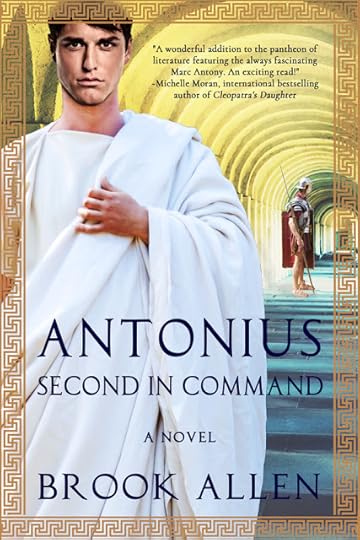
The Antonius saga continues…
Having proven himself as a formidable cavalry commander, Marcus Antonius finally earns a position at his kinsman Julius Caesar’s side. However, Caesar is an exacting general, demanding complete allegiance from his staff, even when his decisions put him at odds with the Senate. Marcus’s loyalty to Caesar comes at a cost, and he soon finds himself embroiled in mob violence and military mutinies. As civil war brings Rome’s Republic crashing down, many a relationship is torn asunder, including Marcus’s marriage. Determined to rise triumphant in Rome’s new era, Marcus faces his fears, his failures, and his enemies—not the least of whom is himself.
Amid the crisis of the Ides of March, Marcus must don the mantle of ruthlessness to carve his own legacy in Rome’s history. Enemies have been made, wills have been read, and heirs proclaimed.
But in Rome’s civil unrest, blood answers only to blood.
Amazon
Brook Allen
 Brook Allen is a Music Educator in a rural community near Roanoke, VA. Aside from her regular classes, she teaches two ensembles, a Chorus and Recorder Consort. Born in Salt Lake City, UT, Brook was raised in Omaha, Nebraska and has lived all over the U.S., from the Pacific Northwest, all the way down to Florida. She graduated with a B.A. in Music Education and has a M. A. in Liberal Studies, with an emphasis on Roman History. Brook is happily married and has two energetic Labrador Retrievers. Voraciously active, she cycles, hikes, and loves to travel.Connect with Brook: Website • Twitter • Facebook.
Brook Allen is a Music Educator in a rural community near Roanoke, VA. Aside from her regular classes, she teaches two ensembles, a Chorus and Recorder Consort. Born in Salt Lake City, UT, Brook was raised in Omaha, Nebraska and has lived all over the U.S., from the Pacific Northwest, all the way down to Florida. She graduated with a B.A. in Music Education and has a M. A. in Liberal Studies, with an emphasis on Roman History. Brook is happily married and has two energetic Labrador Retrievers. Voraciously active, she cycles, hikes, and loves to travel.Connect with Brook: Website • Twitter • Facebook.
Published on December 16, 2019 19:30
Check out Angelina Kalahari's fabulous #NewRelease — Breathing for Confidence: Your Voice, Your Superpower #Singing #performers @angelinakalhari
Breathing for Confidence:Your Voice, Your SuperpowerBy Angelina Kalahari

Start breathing optimally today for better health, great voice production and amazing confidence.With over 35 years teaching, singing, acting, and directing experience and having been recognised by Queen Elizabeth II for her contribution to music, Angelina Kalahari is proud to present the first book in her fabulous new series — Your Voice, Your Superpower.In Angelina's vast experience, she has found that stories are the best ways to learn and more importantly remember what we have learned. Angelina has chosen to use the story of an imaginary voice student, Jake Tyler, to illustrate how important breathing is to improve your health, voice production and self-esteem.So, what are you waiting for? Let Angelina show you how to breathe optimally in a way that supports not only your voice for speaking or singing but also your physical, mental and emotional well-being.
Praise for Angelina Kalahari
“How to breathe? Simple. But many of us performers do it incorrectly. Understanding the body structure and how you see yourself in the mirror. Angelina often made me look myself in the eye in a mirror and sing. I found this hard but that was a lack of confidence and self-esteem all of which Angelina nurtured gradually. Feeling where the sound resonates in the body, the ability to use the pelvic muscles, and using the rib cage to sustain power.” Dawn“The techniques I learned have improved my voice drastically! When I first began singing with Angelina, I had no breath control or support. I soon realised that these skills were vital, and I have really enjoyed hearing my voice evolve as I learned new and more advanced techniques. Every week when I leave Angelina's house, I feel like my voice has improved, but it is great to reminisce on how I sang in 2012 to how I sing now!” Jade“The most important thing I’ve learned is how to make use of the body as an instrument and allow sound to flow freely from within.” Adeolu
Excerpt

This book is about how to breathe optimally in a way that supports not only your voice for speaking or singing but also your physical, mental and emotional well-being.In this first book in my series about voice, I will show you how to breathe optimally daily. Once you become accustomed to the new sensation of breathing in your body, it will become automatic, just as it does for singers and actors who train their breathing to support their art fully. We all know our voice is our most important communications tool. It is often our initial contact with someone over the phone and makes a strong first impression when meeting someone. Breathing is the foundation of good, strong voice production and all the benefits that go with it - confidence, stress relief, better sleep, mental clarity, to name but a few. Starting the series with a book on breathing is, therefore, the obvious route to understanding and developing optimal breathing for further voice work and health.
Pick up your copy ofBreathing for Confidence:Your Voice, Your SuperpowerAmazon • Kobo
Angelina Kalahari
 Angelina Kalahari has worked for over thirty-five years as a professional actress, stage director and operatic soprano, performing around the world. She appeared on many diverse platforms, such as opening the busking scheme on London Underground to a recital at the Royal Opera House and everything in between. She holds degrees in drama and opera and in 2005 she received recognition for her contribution to the music, culture and economy of the UK from Queen Elizabeth II at Buckingham Palace. Angelina has always regarded herself as a storyteller, either through music or through acting and directing. She honed her storytelling skills from a young age, writing and telling stories to her siblings at bedtime. It became a habit through the years and a solace while travelling for singing.Born in Namibia, and having lived all over the world, she currently lives in London, UK, with her husband, her fur cat daughter, a rapidly diminishing population of house spiders and a smallish herd of dust bunnies.She writes non-fiction books on the voice, her specialism and obsession for over thirty-five years, contemporary romance to explore love, women's fiction to understand love and middle-grade novels to give love. What more is there than love?Connect with Angelina: Website • Facebook • Twitter • Instagram • Pinterest • Linkedin • Goodreads • Amazon Author Page.
Angelina Kalahari has worked for over thirty-five years as a professional actress, stage director and operatic soprano, performing around the world. She appeared on many diverse platforms, such as opening the busking scheme on London Underground to a recital at the Royal Opera House and everything in between. She holds degrees in drama and opera and in 2005 she received recognition for her contribution to the music, culture and economy of the UK from Queen Elizabeth II at Buckingham Palace. Angelina has always regarded herself as a storyteller, either through music or through acting and directing. She honed her storytelling skills from a young age, writing and telling stories to her siblings at bedtime. It became a habit through the years and a solace while travelling for singing.Born in Namibia, and having lived all over the world, she currently lives in London, UK, with her husband, her fur cat daughter, a rapidly diminishing population of house spiders and a smallish herd of dust bunnies.She writes non-fiction books on the voice, her specialism and obsession for over thirty-five years, contemporary romance to explore love, women's fiction to understand love and middle-grade novels to give love. What more is there than love?Connect with Angelina: Website • Facebook • Twitter • Instagram • Pinterest • Linkedin • Goodreads • Amazon Author Page.
Published on December 16, 2019 18:30
December 15, 2019
A (not so merry) Tudor Christmas by Judith Arnopp #History #Christmas #Tudors @JudithArnopp
 A (not so merry) Tudor ChristmasBy Judith ArnoppWe tend to imagine medieval and Tudor Christmases as occasions of celebration and feasting; a hall bedecked with greenery, a burning yule log in the hearth, a boar’s head on the table. Wine is flowing, minstrels are playing and misrule is king. Then a giant green knight on a fiery steed breaks through the doors and demands … oh, hang on, that’s another story.In fact, Christmases throughout the Tudor period were peppered with personal sorrow for the monarchs. In December 1495, a few days before Christmas, Jasper Tudor, uncle and prime supporter of Henry VII, died in his bed at Thornbury Castle. He was a great loss to Henry and Margaret Beaufort and his passing must have cast a shadow on their celebrations.A couple of years later on Christmas Eve while the royal family was in residence, Sheen Palace was ravaged by fire but it didn’t stop there. With increasing regularity, the Tudor’s festive season was not a time of joy.
A (not so merry) Tudor ChristmasBy Judith ArnoppWe tend to imagine medieval and Tudor Christmases as occasions of celebration and feasting; a hall bedecked with greenery, a burning yule log in the hearth, a boar’s head on the table. Wine is flowing, minstrels are playing and misrule is king. Then a giant green knight on a fiery steed breaks through the doors and demands … oh, hang on, that’s another story.In fact, Christmases throughout the Tudor period were peppered with personal sorrow for the monarchs. In December 1495, a few days before Christmas, Jasper Tudor, uncle and prime supporter of Henry VII, died in his bed at Thornbury Castle. He was a great loss to Henry and Margaret Beaufort and his passing must have cast a shadow on their celebrations.A couple of years later on Christmas Eve while the royal family was in residence, Sheen Palace was ravaged by fire but it didn’t stop there. With increasing regularity, the Tudor’s festive season was not a time of joy.
 It wasn’t all bad, of course. The first few years of Henry VIII’s reign saw plenty of feasts and masques. One such pageant featured Robin Hood who, to everyone’s studied surprise, turned out to be none other than the king himself and his favourite courtiers all dressed up as his Merry Men. Disguise was a favourite trick of Henry’s, one that he repeated often and, I would imagine to the court, ad nauseam.The following Christmases passed much as one would expect but after an outbreak of sweating sickness in 1517 Henry, ever fearful of contagion, kept a quiet court, watching a masque of Troilus and Creseyde at Eltham Palace.
It wasn’t all bad, of course. The first few years of Henry VIII’s reign saw plenty of feasts and masques. One such pageant featured Robin Hood who, to everyone’s studied surprise, turned out to be none other than the king himself and his favourite courtiers all dressed up as his Merry Men. Disguise was a favourite trick of Henry’s, one that he repeated often and, I would imagine to the court, ad nauseam.The following Christmases passed much as one would expect but after an outbreak of sweating sickness in 1517 Henry, ever fearful of contagion, kept a quiet court, watching a masque of Troilus and Creseyde at Eltham Palace.
 1526 was a better year. The ten-year-old Princess Mary danced at court, an event that must have proved a poignant memory for Mary for by the following Christmas her life had changed. Her mother had been replaced in Henry’s affections by Anne Boleyn and the king’s ‘secret matter’ was under way. By 1531 Queen Catherine had been banished from court and the seasonal festivities were joyless. By New Year of 1532 Anne had publicly taken Catherine’s place, holding court as if she were indeed the queen. This year the king returned Queen Catherine’s gifts, saying that since he was not her husband it was inappropriate for her to send him gifts.Just two years later, despite now being queen, Christmas must have been difficult for Anne Boleyn. She had recently miscarried her second child, lost her small dog when he fell from a window (or was he pushed?) and quarrelled with her uncle, the duke of Norfolk. It was the beginning of the end for Anne, having failed to provide a male heir she had lost Henry’s love and was now an irritation to the king; he couldn’t wait to be rid of her. Cromwell at his master’s behest made sure this was so, and in May 1536 Anne was beheaded.
1526 was a better year. The ten-year-old Princess Mary danced at court, an event that must have proved a poignant memory for Mary for by the following Christmas her life had changed. Her mother had been replaced in Henry’s affections by Anne Boleyn and the king’s ‘secret matter’ was under way. By 1531 Queen Catherine had been banished from court and the seasonal festivities were joyless. By New Year of 1532 Anne had publicly taken Catherine’s place, holding court as if she were indeed the queen. This year the king returned Queen Catherine’s gifts, saying that since he was not her husband it was inappropriate for her to send him gifts.Just two years later, despite now being queen, Christmas must have been difficult for Anne Boleyn. She had recently miscarried her second child, lost her small dog when he fell from a window (or was he pushed?) and quarrelled with her uncle, the duke of Norfolk. It was the beginning of the end for Anne, having failed to provide a male heir she had lost Henry’s love and was now an irritation to the king; he couldn’t wait to be rid of her. Cromwell at his master’s behest made sure this was so, and in May 1536 Anne was beheaded.

The winter of 1536-7 was a cold one, the country was ice-locked and the roads impassable but the Thames was frozen solid and the king undeterred. The new queen, Jane Seymour, entreated the king to invite Princess Mary to join them for the Christmas celebration and on the twenty second of December the royal party travelled on the frozen river from Westminster to Greenwich.There was another guest at Christmas this year. In response to the dissolution of the monasteries, the north of the country was in open rebellion. The rebels far outnumbered the king’s army so Henry, pretending to consider their demands, invited the leader Robert Aske to join the Christmas celebration. He bestowed a velvet coat on Aske and treated him royally, but when trouble broke out afresh in the north, Aske was headed for trouble. Although he offered to help the king quell the rising, Cromwell, who was the prime target of the rebels, went out of his way to implicate Aske in the latest rebellion. In July 1537, after a short and unjust trial, Aske was condemned to die a traitor’s death. He was hung alive in chains over the walls of Clifford’s Tower in York as an example of what happens to those who act against the wishes of the king.As we all know, Queen Jane died in October 1537 shortly after giving Henry his longed-for heir. Henry spent the Christmas of 1537 grieving quietly at Greenwich. But by Christmas 1540, he was recovered enough to be persuaded to take another wife, and a few days after the celebrations, a new bride landed at Dover.After a seventeen hour journey, Anne of Cleves arrived in England in the midst of a bitter storm. She travelled across country for as long as she could but in the end the weather forced her to take refuge at Rochester Castle. Henry, impatient to meet his new bride whom he had only seen in the now famous Holbein miniature, set off to meet her. Expecting a woman of radiant beauty, he found something quite different and although he treated her with grace, after leaving the meeting, the fastidious king fell into a great rage, claiming he had never been ‘so much dismayed in his life as to see a lady so far unlike what had been represented.’ To Cromwell’s horror, the marriage was annulled and by July, Anne of Cleves had been replaced by the very young, very beautiful and very unwise, Katherine Howard, and Cromwell was dead.
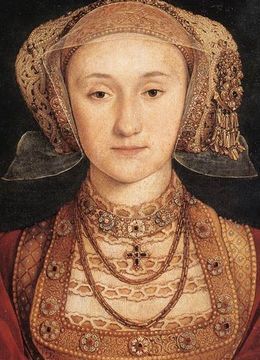 Henry and Katherine had just one Christmas together. They spent it at Hampton Court where he showered gifts of jewels and furs upon her. The king’s eldest daughter, Mary, and his shunned wife, Anne of Cleves, joined them for the New Year. Anne gave the king a pair of horses in expensive trappings. Henry gave Katherine two lap dogs, one of which she impulsively passed on to Anne. By all accounts, it was a joyous time. The king had finally found happiness but, by Christmas 1541 Katherine had fallen and was under house arrest at Syon Abbey accused of treason and adultery. Those accused with her, Tomas Culpepper and Francis Dereham met their death on the 10thof December 1541 – Culpepper was executed as befit his station but Dereham was hung, drawn and quartered. For Katherine at Syon there were no presents, and no festive joy that year … or ever again.The king spent a miserable Christmas, sunk in depression at having lost not only his wife but his friend and servant, Thomas Culpepper. Showing no interest in the celebrations, the ageing king neither sought, nor found any solace. It was after Katherine’s demise that he began to gain weight and it soon became clear that his vigour was gone; he was old. The betrayal and execution of Katherine in February 1542 was the beginning of the end for Henry but in July 1543 he gave marriage one more shot and wed his sixth and final wife, Katherine Parr.Despite the war with Scotland, Henry and Katherine spent their first Christmas at Hampton court. Eager to reunite the king with his off spring, Katherine Parr provided the royal children with a dependable mother figure. In 1545 Princess Elizabeth presented her with a translation of The Mirror of the Sinful Soul which she dedicated to Katherine, ‘the most noble and virtuous’ and signed it from ‘her humble daughter, wisheth perpetual felicity and everlasting joy.’
Henry and Katherine had just one Christmas together. They spent it at Hampton Court where he showered gifts of jewels and furs upon her. The king’s eldest daughter, Mary, and his shunned wife, Anne of Cleves, joined them for the New Year. Anne gave the king a pair of horses in expensive trappings. Henry gave Katherine two lap dogs, one of which she impulsively passed on to Anne. By all accounts, it was a joyous time. The king had finally found happiness but, by Christmas 1541 Katherine had fallen and was under house arrest at Syon Abbey accused of treason and adultery. Those accused with her, Tomas Culpepper and Francis Dereham met their death on the 10thof December 1541 – Culpepper was executed as befit his station but Dereham was hung, drawn and quartered. For Katherine at Syon there were no presents, and no festive joy that year … or ever again.The king spent a miserable Christmas, sunk in depression at having lost not only his wife but his friend and servant, Thomas Culpepper. Showing no interest in the celebrations, the ageing king neither sought, nor found any solace. It was after Katherine’s demise that he began to gain weight and it soon became clear that his vigour was gone; he was old. The betrayal and execution of Katherine in February 1542 was the beginning of the end for Henry but in July 1543 he gave marriage one more shot and wed his sixth and final wife, Katherine Parr.Despite the war with Scotland, Henry and Katherine spent their first Christmas at Hampton court. Eager to reunite the king with his off spring, Katherine Parr provided the royal children with a dependable mother figure. In 1545 Princess Elizabeth presented her with a translation of The Mirror of the Sinful Soul which she dedicated to Katherine, ‘the most noble and virtuous’ and signed it from ‘her humble daughter, wisheth perpetual felicity and everlasting joy.’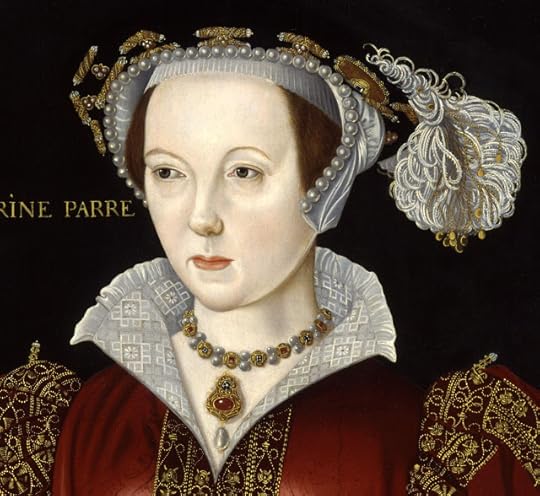
However, despite this interlude of royal contentment, the king’s health was fading, and he grown so weak he was often forced to resort to a wheeled chair. In 1546, on Christmas Eve, he addressed parliament, using words so touching that his listeners were reduced to tears. Shortly after what was to be Henry’s last public speech, the king became so ill that Christmas was cancelled. By 27th of December the physicians admitted they could do no more and on the 30th of December the king made his will.But then he seemed to rally again, and he and Katherine travelled to London on the 3rd of January but by 28th of that month the king was dead. The prince who had ascended the throne with so much potential was gone; the vibrant young king, a lover of masque and cunning disguise had been usurped, and transformed into a failed and embittered tyrant.
The Heretic Wind:The Life of Mary Tudor, Queen of EnglandBy Judith Arnopp

Adored by her parents and pampered by the court, the infant Princess Mary’s life changes suddenly and drastically when her father’s eye is taken by the enigmatic Anne Boleyn.
Mary stands firm against her father’s determination to destroy both her mother’s reputation, and the Catholic church. It is a battle that will last throughout both her father’s and her brother’s reign, until, she is almost broken by persecution. When King Edward falls ill and dies Mary expects to be crowned queen.
But she has reckoned without John Dudley, the Duke of Northumberland, who before Mary can act, usurps her crown and places it on the head of her Protestant cousin, Lady Jane Grey.
Furious and determined not to be beaten, Mary musters a vast army at Framlingham Castle; a force so strong that Jane Grey’s supporters crumble in the face of it, and Mary is at last crowned Queen of England.
But her troubles are only just beginning. Rebellion and heresy take their toll both on Mary’s health, and on the English people. Suspecting she is fatally ill, and desperate to save her people from heresy, Mary steps up her campaign to compel her subjects to turn back to the Catholic faith.
All who resist will face punishment for heresy in the flames of the Smithfield fires.
Pre-order your copy TODAY!AmazonReleased 27th January
Judith Arnopp
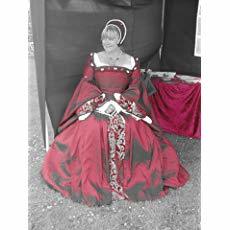 Judith Arnopp writes historical fiction set mainly in the late medieval and Tudor period. Her work includes:The Heretic Wind: the story of Mary Tudor, Queen of EnglandSisters of Arden: on the Pilgrimage of GraceThe Beaufort Chronicles: the life of Lady Margaret Beaufort (three book series)A Song of Sixpence: the story of Elizabeth of YorkThe Kiss of the Concubine: a story of Anne BoleynThe Winchester Goose: at the court of Henry VIIIIntractable Heart: the life of Katherine ParrThe Song of HeleddThe Forest DwellersPeaceweaver
Judith Arnopp writes historical fiction set mainly in the late medieval and Tudor period. Her work includes:The Heretic Wind: the story of Mary Tudor, Queen of EnglandSisters of Arden: on the Pilgrimage of GraceThe Beaufort Chronicles: the life of Lady Margaret Beaufort (three book series)A Song of Sixpence: the story of Elizabeth of YorkThe Kiss of the Concubine: a story of Anne BoleynThe Winchester Goose: at the court of Henry VIIIIntractable Heart: the life of Katherine ParrThe Song of HeleddThe Forest DwellersPeaceweaverConnect with Judith: Facebook • Twitter • Website • Blog.

Illustrations:Tretower table – Judith ArnoppElizabethan feast - Alonso Sánchez Coello [Public domain]Old King Cole Walter Crane [Public domain], via Wikimedia CommonsAnne Boleyn – national portrait galleryAnne of Cleves – wiki commonsBringing in the boars head - Supplement to the Illustrated London News, 1855. [Public domain],via Wikimedia.Katherine Parr – Wikimedia commons
Published on December 15, 2019 21:00
#BookReview — Bright Blade (The Byrhtnoth Chronicles, Book #3) by Christine Hancock #HistoricalFiction
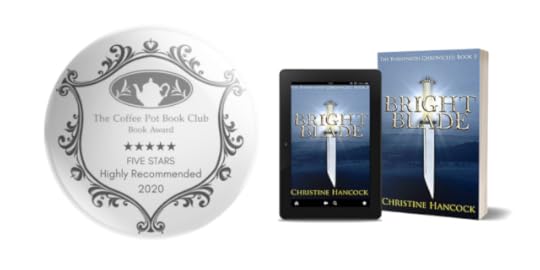 Bright Blade:(The Byrhtnoth Chronicles, Book #3)By Christine Hancock
Bright Blade:(The Byrhtnoth Chronicles, Book #3)By Christine Hancock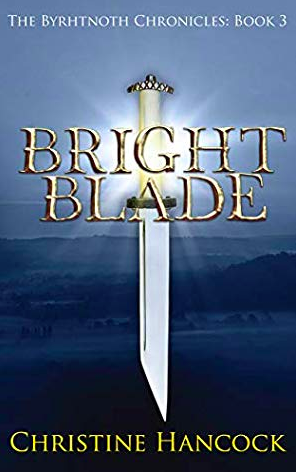
Byrhtnoth thinks only of killing the man who stole his sword and wounded his wife. But the blade of revenge can strike both ways.
Erik Bloodaxe has broken his oath and claimed the throne of York. In his anger, King Eadred sends his army to ravage Northumbria.
Sent north with the ships, Byrhtnoth suffers storms at sea and fire on land.After an encounter with an old enemy he is left broken, in mind and body.
Can Byrhtnoth survive until help arrives?
Will he ever fight again?

"Does the king think that by laying waste to the country, he will make peace? He can't kill everyone in Northumbria..."
Who says he cannot?
King Eadred is determined to bring Northumbria back to heel, and most of his earls were in favour of war. For Thegn Byrhtnoth, his first duty would always be to his king, and Lord Athelstan. Which means that even though Byrhtnoth had no desire to fight in King Eadred's war with the North, he has no choice but to obey. Byrhtnoth's search for his father and his vow to avenge his wife against the man who had used her so terribly would have to wait — for now, at least.
By order of the King, Byrhtnoth finds himself in Devon and overseeing the repairing and the preparation of a small fleet of ships that had long since been abandoned by the sailors who grew tired of waiting for the money owed to them by King Eadred. To get these ships ready in time is an enormous undertaking, but with wit and coin, Byrhtnoth is determined to have the boats as prepared as they can be on such short notice.
Yet, this war, when it comes, would be unlike anything Byrhtnoth had ever witnessed. This is a war on the people of the North, not just her army and her king. Such a war can only bring out the very worst in men. While Byrhtnoth tries to bring order to the chaos, and stop his men from murdering and raping indiscriminately, he is naively unaware that his old enemy, Egbert, is closing in on him.
Only time will tell if Byrhtnoth will ever see his wife and his beloved Essex again.
From doubts of a king's fitness to rule, to the burning of the monastery at Ripon, and a fight against time to save a man's life, Bright Blade (The Byrhtnoth Chronicles, Book #3) by Christine Hancock is the memorable story of Thegn Byrhtnoth of Essex as he tries to balance the want of his king with his own desire for revenge.
Bright Blade is the impressively dramatic account of King Eadred's wrath on the North, seen through the eyes of a young Thegn. Hancock immerses her readers in the turbulent world that was the 10th Century. This was a time when loyalties were sorely tested, and war left a bitter taste in the mouth as well as blood on the ground. Hancock has masterfully brought this world back to life.
We experience the preparation, the raids and the war on the North through Byrhtnoth’s eyes. Byrhtnoth has a sharp intelligence and such a loving heart, which made his character utterly irresistible. Here is a hero that a reader can really get behind, and get behind him I did. He is a man of deep morals and one that I enjoyed reading about very much. As a historical character, Byrhtnoth is quite challenging to pin down, but I thought Hancock did an excellent job of bringing this little known 10th-century Saxon Ealdorman of Essex back to life.
As before with Book #2, I adored the characterisation of Saewynn. Saewynn was subjected to terrible abuse in Book #2, and in Bright Blade, we see the consequences of this abuse. Her bravery, her courage, and her determination to face her fears, made for an unforgettable read. Her narrative, particularly in the latter half of this book, really drove the story forward and made this book unputdownable.
Throughout this novel is a thinly concealed menace that means neither Byrhtnoth nor Saewynn can ever feel completely at ease. Egbert is as vile in this book as he was in the last one. His desire to harm both Byrhtnoth and Saewynn is an ever-present threat. He really is an utterly despicable character. But, Hancock lets her readers glimpse into the reason why he behaves how he does. It, in no way, excuses him, but Hancock has given her readers a little insight into what is going on in his mind.
Hancock pays meticulous attention to the historical detail while having a keen eye on what makes for an entertaining read. In particular, Hancock's depiction of the preparation, sailing, and the battles on the ships was incredibly realistic in the telling. These scenes, especially, were written with a great deal of imagination and energy. Hancock has an intuitive understanding of what makes history worth reading, and she has shined a light into this somewhat dark period in British history.
Hancock writes with both grace and authority, and although Bright Blade is book #3 in this series, it stands very firmly on its own two feet. The impressive narrative is not only enthralling, but it is also unashamedly compelling. I was utterly enchanted with the story from start to finish. There was nothing about this book that I did not like. It is an immensely readable tale and a very enjoyable one as well.
If you are looking for your next great historical fiction novel series set in the Dark Ages, then look no further than The Byrhtnoth Chronicles.
I Highly Recommend.
Review by Mary Anne Yarde.The Coffee Pot Book Club.
<!-- /* Font Definitions */ @font-face {font-family:"Cambria Math"; panose-1:2 4 5 3 5 4 6 3 2 4; mso-font-charset:0; mso-generic-font-family:roman; mso-font-pitch:variable; mso-font-signature:-536870145 1107305727 0 0 415 0;} /* Style Definitions */ p.MsoNormal, li.MsoNormal, div.MsoNormal {mso-style-unhide:no; mso-style-qformat:yes; mso-style-parent:""; margin:0cm; margin-bottom:.0001pt; mso-pagination:widow-orphan; font-size:12.0pt; font-family:"Times New Roman",serif; mso-fareast-font-family:"Times New Roman";} p {mso-style-noshow:yes; mso-style-priority:99; mso-margin-top-alt:auto; margin-right:0cm; mso-margin-bottom-alt:auto; margin-left:0cm; mso-pagination:widow-orphan; font-size:12.0pt; font-family:"Times New Roman",serif; mso-fareast-font-family:"Times New Roman";} .MsoChpDefault {mso-style-type:export-only; mso-default-props:yes; font-family:"Calibri",sans-serif; mso-ascii-font-family:Calibri; mso-ascii-theme-font:minor-latin; mso-fareast-font-family:Calibri; mso-fareast-theme-font:minor-latin; mso-hansi-font-family:Calibri; mso-hansi-theme-font:minor-latin; mso-bidi-font-family:"Times New Roman"; mso-bidi-theme-font:minor-bidi; mso-fareast-language:EN-US;} @page WordSection1 {size:612.0pt 792.0pt; margin:72.0pt 72.0pt 72.0pt 72.0pt; mso-header-margin:36.0pt; mso-footer-margin:36.0pt; mso-paper-source:0;} div.WordSection1 {page:WordSection1;} </style></div><div style="text-align: center;"><span style="color: #666666; font-family: "times" , "times new roman" , serif;"><span style="font-size: 35pt;">Pick up </span><span style="font-size: 35pt; text-align: center;">your copy of</span></span></div><div style="line-height: 150%; margin-bottom: .0001pt; margin: 0cm; text-align: center;"><i><span style="font-size: 35pt; line-height: 150%;"><span style="color: #666666; font-family: "times" , "times new roman" , serif;">Bright Blade<o:p></o:p></span></span></i></div><div style="line-height: 150%; margin-bottom: .0001pt; margin: 0cm; text-align: center;"><span style="font-size: 35pt; line-height: 150%;"><span style="color: #666666; font-family: "times" , "times new roman" , serif;"><a href="https://www.amazon.co.uk/gp/product/B... UK</a> • <a href="https://www.amazon.com/Bright-Blade-B... US</a><o:p></o:p></span></span></div><div style="margin: 0cm 0cm 0.0001pt; text-align: center;"><span style="font-size: 35pt;"><span style="color: #666666; font-family: "times" , "times new roman" , serif;"><br /></span></span></div><div style="margin-bottom: .0001pt; margin: 0cm; mso-line-height-alt: 21.0pt;"><span style="font-size: 35pt;"><span style="color: #666666; font-family: "times" , "times new roman" , serif;"><br /></span></span></div><div style="margin-bottom: .0001pt; margin: 0cm; mso-line-height-alt: 21.0pt;"><span style="font-size: 35pt;"><span style="font-family: "times" , "times new roman" , serif;"><span style="color: #666666;">Christine Hancock</span><span style="color: #333333;"><o:p></o:p></span></span></span></div><div style="line-height: 21.0pt; margin-bottom: .0001pt; margin: 0cm;"><br /></div><div class="separator" style="clear: both; text-align: center;"><a href="https://1.bp.blogspot.com/-ZRVHWVgtoM..." imageanchor="1" style="clear: left; float: left; margin-bottom: 1em; margin-right: 1em;"><span style="font-family: "times" , "times new roman" , serif;"><img border="0" data-original-height="320" data-original-width="240" src="https://1.bp.blogspot.com/-ZRVHWVgtoM..." /></span></a></div><div class="MsoNormal" style="background: white; line-height: 21.0pt;"><span style="color: #333333; font-size: 16.0pt;"><span style="font-family: "times" , "times new roman" , serif;">I was born in Essex and moved to Rugby, Warwickshire when I married. I have a husband, two sons and two lovely grandchildren.<o:p></o:p></span></span></div><div class="MsoNormal" style="background: white; line-height: 21.0pt;"><br /></div><div class="MsoNormal" style="background: white; line-height: 21.0pt;"><span style="color: #333333; font-size: 16.0pt;"><span style="font-family: "times" , "times new roman" , serif;">I am a long-term family historian, leader of the local history group and town guide.<o:p></o:p></span></span></div><div class="MsoNormal" style="background: white; line-height: 21.0pt;"><br /></div><div class="MsoNormal" style="background: white; line-height: 21.0pt;"><span style="color: #333333; font-size: 16.0pt;"><span style="font-family: "times" , "times new roman" , serif;">I had never thought of becoming an author – I just wanted to write about some of my ancestors. In 2013 I joined a writing class. The class turned out to be about writing fiction. Before I knew it, I was writing a novel.<o:p></o:p></span></span></div><div class="MsoNormal" style="background: white; line-height: 21.0pt;"><br /></div><div class="MsoNormal" style="background: white; line-height: 21.0pt;"><span style="color: #333333; font-size: 16.0pt;"><span style="font-family: "times" , "times new roman" , serif;">Byrhtnoth was a real warrior who died in the 991 Battle of Maldon, made famous by the Anglo-Saxon poem of that name. Growing up in Essex, I visited Maldon often, and attended the 1000 year anniversary of the battle in 1991.<o:p></o:p></span></span></div><div class="MsoNormal" style="background: white; line-height: 21.0pt;"><span style="color: #333333; font-size: 16.0pt;"><span style="font-family: "times" , "times new roman" , serif;">I wanted to find out what made Byrhtnoth such a famous warrior.<o:p></o:p></span></span></div><div class="MsoNormal" style="background: white; line-height: 21.0pt;"><br /></div><div class="MsoNormal" style="background: white; line-height: 21.0pt;"><span style="color: #333333; font-size: 16.0pt;"><span style="font-family: "times" , "times new roman" , serif;">I finished the book but found it had become a series – how long, I have yet to find out.<o:p></o:p></span></span></div><div class="MsoNormal" style="background: white; line-height: 21.0pt;"><br /></div><div align="center" class="MsoNormal" style="background: white; line-height: 21.0pt; text-align: center;"><span style="color: #333333; font-size: 16.0pt;"><span style="font-family: "times" , "times new roman" , serif;">Connect with Christine: <a href="https://byrhtnoth.com/"><span style="color: #954f72;">Blog</span></a> • <a href="https://www.facebook.com/ByrhtnothAut... style="color: #954f72;">Facebook</span></a> • <a href="https://twitter.com/YoungByrhtnoth&qu... style="color: #954f72;">Twitter</span></a><o:p></o:p></span></span></div><div class="MsoNormal"><br /></div><div style="margin-bottom: .0001pt; margin: 0cm;"><br /></div><div class="MsoNormal"><br /></div><div class="MsoNormal"><o:p><br /></o:p></div><div class="MsoNormal"><br /></div>
Published on December 15, 2019 20:00
December 13, 2019
Join Historical Romance author, Mary Morgan, as she is celebrating the season. There is also a chance to check out Mary's fabulous book — To Weave A Highland Tapestry @m_morganauthor
 Celebrating the Season
Celebrating the SeasonBy Mary Morgan
In pre-Christian times, people used to liven up the dark days of the Winter Solstice with a celebration of fire, feasting, and light. The burning of the fires was to ward off dark and evil spirits. The tradition of decorating the home with evergreens is an ancient one. Since pagan times, evergreens have been prized for the ability to maintain their green life in winter. And often times, blooming with berries and/or flowers.

Kissing boughs for the Winter Solstice and Christmas hail from medieval times. Evergreen branches were placed throughout the halls of manor houses and castles. It was thought to bring good cheer and health to anyone passing under them. The kissing bough was the precursor to kissing under the mistletoe. In addition, this plant was also sacred to the Druids. It was believed to bring good fortune, fertility, protection, and healing.
In my story, To Weave A Highland Tapestry, I’ve incorporated the kissing bough for the Winter Solstice celebration. Holly, ivy, pine, and evergreen herbs (bay and rosemary) were most commonly used, along with twigs and fruit. Since the women in my story have journeyed back in time to medieval Scotland, I might have introduced these round balls a bit earlier in time. Regardless, I enjoyed weaving a tradition within the story.
Merry Christmas and a Happy Winter Solstice!
To Weave A Highland TapestryBy Mary Morgan

Patrick MacFhearguis, hardened by battles won and lost, desires what he can never have—peace within his heart and soul. Yet, the ever-meddling Fae weave a new journey for him to conquer—a task this highlander is determined to resist.When skilled weaver, Gwen Hywel, is commissioned to create a tapestry for the MacFhearguis clan, she embraces the assignment. While seeking out ideas, she finds herself clutching the one thread that can alter the tapestry of her life and heart.A man conflicted by past deeds. A woman with no family of her own. Is it possible for love to unravel an ancient past, in order to claim two badly scarred hearts? Or will the light of hope be doused forever?
Excerpt
His kiss was urgent, demanding. Patrick thrust his tongue into her soft heat. The air swirled in a tempest of passion as the kiss deepened. No longer caring if anyone came upon them, Patrick continued to feast on her mouth.
“How many kissing boughs have our wives placed in this castle?” asked Stephen.
“In every nook, stone, and chamber. I would not be surprised to find one in the stables or lists,” replied Duncan.
Stephen laughed. “By the hounds, I do love Midwinter.”
Gwen stiffened against Patrick. Placing a finger over her mouth, he waited for the conversation to fade before relaxing his stance and stepping back. Glancing over his shoulder, he watched as the men made their way into the feasting hall. Returning his attention to Gwen, he pulled her out of the alcove.
Her cheeks were stained a becoming pink, and full lips begged to be kissed again. Patrick raked a hand through his hair, doing his best to refrain from backing her inside the hidden enclosure again.
She giggled and stole a glance upward within the alcove. “Yes. We can blame it on the kissing boughs.”
He laughed nervously. “This is a first.”
“Are you confessing you’ve never kissed another under these boughs?”
Reaching for her hand, he caressed her fingers. “Never. Leòmhann has seen many a Midwinter feast, but no one dared to place these kissing boughs within the castle.”
She tilted her head to the side. Her joyful expression faded. “May I ask why?”
Once again, Patrick was reminded of the curse which surrounded his home. He looked down at her tiny hand. What could he offer Gwen? Why did he continue to pursue her without the promise of tomorrow? Should he confess all to her now?
She squeezed his hand. “If it’s too painful to talk about, I’ll understand. Let us enjoy this evening and not dwell on unhappy thoughts.”
Her words brought comfort to Patrick’s tortured spirit. Giving her a weak smile, he brought her hand into the crook of his arm. “Ye are correct. Let us welcome the light of Midwinter tonight.”
Patrick’s steps slowed as he guided them into the hall. The atmosphere was one of cheerfulness, laughter, and music. Greenery adorned the entire room—from wooden beams to tables. Children scurried past them in glee, and his heart leaped at the sight.
“My goodness. It’s beautiful,” observed Gwen, leaning against him. “And look, they’ve brought Meggie’s tapestry back inside the hall. The MacKays surely know how to celebrate.”
Within that moment, Patrick made a silent vow that one day he would see the same light enter his home. His heart soared at the possibility. With ye by my side, Gwen, I shall give ye this beauty.
Pick up your copy ofTo Weave A Highland TapestryAmazon UK • Amazon US • Amazon CA • Amazon AU • Barnes and Noble • AppleBooks
Mary Morgan
 Award-winning Celtic paranormal and fantasy romance author, Mary Morgan, resides in Northern California with her own knight in shining armor. However, during her travels to Scotland, England, and Ireland, she left a part of her soul in one of these countries and vows to return.
Award-winning Celtic paranormal and fantasy romance author, Mary Morgan, resides in Northern California with her own knight in shining armor. However, during her travels to Scotland, England, and Ireland, she left a part of her soul in one of these countries and vows to return.
Mary's passion for books started at an early age along with an overactive imagination. Inspired by her love for history and ancient Celtic mythology, her tales are filled with powerful warriors, brave women, magic, and romance. It wasn't until the closure of Borders Books where Mary worked that she found her true calling by writing romance. Now, the worlds she created in her mind are coming to life within her stories.
If you enjoy history, tortured heroes, and a wee bit of magic, then time-travel within the pages of her books.
Connect with Mary: Website/Blog • Twitter • Facebook • Goodreads• Amazon Author Page• Pinterest • Instagram • BookBub • Linkedin • Audible Author Page.
Published on December 13, 2019 20:00
December 12, 2019
#BookReview — Revenge and Retribution (The Graham Saga #6) by Anna Belfrage #HistoricalFiction #TimeTravel @abelfrageauthor
 Revenge and Retribution(The Graham Saga #6)By Anna Belfrage
Revenge and Retribution(The Graham Saga #6)By Anna Belfrage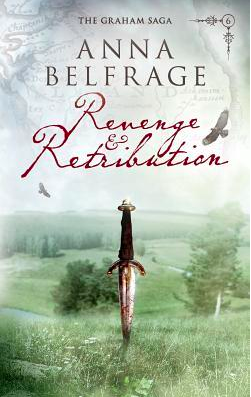
Life in the Colony of Maryland is no sinecure - as Alex and Matthew Graham well know. But nothing in their previous life has prepared them for the mayhem that is about to be unleashed upon them. Being labelled a witch is not a good thing in 1684, so it is no wonder Alex Graham is aghast at having such insinuations thrown at her. Even worse, it's Matthew's brother-in-law, Simon Melville, who points finger at her. Not that the ensuing hearing is her main concern, because nowadays Alex's entire life is tainted by the fear of what Philip Burley will do to them once he gets hold of them. On a sunny May afternoon, Philip finally achieves his aim and over the course of the coming days Alex sees her whole life unravelling, leaving her family permanently maimed. As if all this wasn't enough, Alex also has to cope with the loss of one of her sons. Forcibly adopted by the former Susquehannock, Samuel is dragged from Alex's arms to begin a new life in the wilderness. How is Alex to survive all this? And will she be able to put her damaged family back together?

"Go and ask her, ask Alex Graham where those witch things come from..."
Matthew Graham had not expected his brother-in-law to accuse his wife, Alex, of witchcraft. After everything they had been through together, it was nigh on impossible to comprehend such a betrayal. But words, when spoken, cannot be taken back. Alex is forced to come face to face with her past with devastating consequences.
But an accusation of witchcraft is not the only thing the Grahams have to worry about. Philip Burley has been plotting his revenge against Matthew for many years. He is determined to be judge, torturer and executioner. Matthew would know suffering, and he would know pain — the likes of which he had never felt before, and this time there would be no one who would come to his rescue, for Burley, and his gang would make sure of it.
For Matthew and Alex, the year 1684 would leave both physical and mental scars. 1684 would be the year that their lives were changed forever.
Revenge and Retribution (The Graham Saga #6) by Anna Belfrage is utterly enchanting from start to finish. It is a book that will haunt me for a very long time and one that will be impossible for me to forget.
Oh, this book and these characters... I have never read a series that has ensnared my heart like The Graham Saga. It is an elegantly narrated story that captured my imagination from the very beginning, and with each book, there comes a deeper understanding of the lives of this family in an utterly captivating era. This series deserves the highest of acclaim, not only for its historical accuracy and unforgettable characters but also for Belfrage's ability to keep the momentum going. There isn't a dull moment in this series, and there certainly isn't one in this book. Revenge and Retribution has everything a lover of sweeping family sagas set in a bygone era could possibly wish for. It is, in all ways, triumphant.
As with the previous books, Revenge and Retribution follow the lives of Matthew and Alex Graham. The more I read about these two characters the more I grow to love them. Their trials and heartaches are softened by their undeniable and unstoppable love for each other. Of all the books in this series, this one was without a doubt, the more heart-rendering and shocking. As the title states, this book is about revenge and retribution. It is, at times, incredibly dark, but at the same time, it is also a story of hope and healing. I have never read a book like it. I thought it was absolutely brilliant. Kudos, Ms Belfrage. Kudos, indeed.
We are once again reunited with the beastly Burley brothers. These men are worse than vermin. They are parasites, and a constant threat. They are disgusting and vile and truly terrible. There are not enough adjectives to describe how much I loathe these characters. These despicable antagonists, however, made this book unputdownable. There is one thing you can say about Belfrage — she knows how to cast good villains, which leads me onto another, one that at first glance is the essence of innocence. Lucy Jones was born deaf. Her life is one of silence. And yet, she married well and has three adorable children, but, it isn't enough for her.
Lucy wants her husband to love her and treat her with as much praise and care as her father does. But Henry's womanising ways and his inexplicable fear of his young wife means that he stays away from her bedchamber more often than he should. But Lucy isn't the type of woman who will sit back and allow him to do whatever he wants. She means to make him hers and hers alone. Lucy has a weapon that will ensure that she will be the only woman in his life. This weapon is a painting. This painting is a portal through time. Lucy was a character that made me feel terribly conflicted. I could sympathise with her plight and her frustrations, but at the same time, there is a cruelty to Lucy's personality that made me somewhat fearful of her and for anyone who upset her in any way. She was almost without mercy. Lucy reminded me very much of a very spoilt child, and although she is in a terribly unhappy marriage, and she feels stilted by her disability, I found it very hard to like her. I can understand why her husband is somewhat fearful of her. She is this silent, menacing force of nature — at times, Lucy truly terrified me. I never expected to have such a strong adverse reaction to Lucy — this is a character who was born and grew up within the pages of this series, and I wasn't expecting her to turn out quite the way she did. I thought Belfrage did a marvellous job in her portrayal of Lucy. This was a seemingly innocent secondary character that suddenly has within her grasp the power to destroy the lives of the Grahams inadvertently — as if the Grahams did not have enough to deal with! I thought Lucy was magnificently portrayed and she certainly helped to drive this story forward.
Belfrage has captured not only the essence of this era, but also the wildness, and the inherent beauty of the Colony of Maryland during this time in American history. There is a richness to the storytelling, an understanding of this era in the elegant prose and vivacious narrative. Revenge and Retribution is the sort of book that, like a magical portal, takes the reader back in time, and you see everything in vivid technicolour. The Graham Saga is in all ways a masterpiece, but this book transcends everything that came before it. I don't think I have ever read a book that has affected me quite so much as Revenge and Retribution. This story is not for the faint-hearted, some of the things that happen are absolutely brutal, and the fact that these terrible, terrible things are happening to characters that over of the course of this series I come to adore made it all the more heartbreakingly tragic.
The Graham Saga is undoubtedly one of the best series I have ever read. Fans of Diana Gabaldon's Outlander will fall in love with this series and cherish this book.
I Highly Recommend.
Review by Mary Anne Yarde.The Coffee Pot Book Club.
Pick up your copy ofRevenge and RetributionAmazon UK • Amazon US
Anna Belfrage
 Had Anna been allowed to choose, she’d have become a time-traveller. As this was impossible, she became a financial professional with two absorbing interests: history and writing. Anna has authored the acclaimed time travelling series The Graham Saga, set in 17th century Scotland and Maryland, as well as the equally acclaimed medieval series The King’s Greatest Enemy which is set in 14th century England. She has recently released the first in a new series, The Wanderer. This time, she steps out of her normal historical context and A Torch in His Heart is with a fast-paced contemporary romantic suspense with paranormal and time-slip ingredients.
Had Anna been allowed to choose, she’d have become a time-traveller. As this was impossible, she became a financial professional with two absorbing interests: history and writing. Anna has authored the acclaimed time travelling series The Graham Saga, set in 17th century Scotland and Maryland, as well as the equally acclaimed medieval series The King’s Greatest Enemy which is set in 14th century England. She has recently released the first in a new series, The Wanderer. This time, she steps out of her normal historical context and A Torch in His Heart is with a fast-paced contemporary romantic suspense with paranormal and time-slip ingredients.Find out more about Anna by visiting her website, or herAmazon page.
Published on December 12, 2019 21:00
Christmas in Hollywood in the Time of Hedy Lamarr by Margaret Porter #History #Christmas @MargaretAuthor
 Christmas in Hollywood in the Time of Hedy LamarrBy Margaret Porter
Christmas in Hollywood in the Time of Hedy LamarrBy Margaret Porter
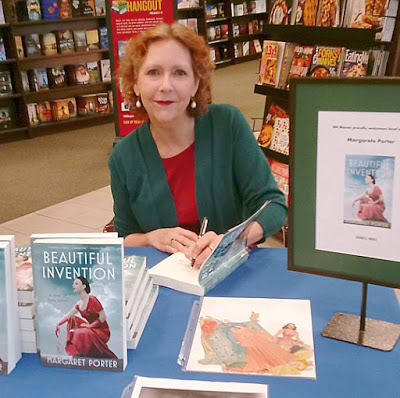
On October 4, 1937, twenty-three-year old Hedy Lamarr arrived in Tinseltown, having crossed the Atlantic on the luxury liner Normandie and the whole of the United States by train. She spoke hardly any English, her widowed mother was in Austria, and she had no American friends. On her first Christmas in California, she must have greatly missed her national customs. Sunshine and milder December temperatures were a contrast to her homeland’s frigid winter air and the snowy Alps where Hedy loved to ski.

With Nazi Germany posing a threat to Jewish and other European actors, directors, cinematographers, and other, many sought refuge and career opportunities in Hollywood, just as Hedy had done. They brought with them their own December traditions and rituals, Christian or Jewish, so in many households the holidays had an international flavour.With the approach of the festive season, Christmas productions and plays for children—like Babes in Toyland—were prevalent. Charitable organisations took in collections and arranged for the preparation and distributions of Christmas baskets. On Christmas Eve, musical societies and choral guilds in Los Angeles went out into the streets and the city parks, and to hospitals, singing carols. Los Angeles was a city of restaurants and nightclubs, and throughout December these were venues for private parties where the gifted and the glamourous gathered to celebrate. Suggested recipes for holiday goodies were printed in newspapers and fan magazines. In December 1938, a cookery expert gave a ‘Yuletide Yummies’ workshop to demonstrate how to make English-style Christmas cake (fruit cake), and Christmas pudding with brandy sauce. Movie star Greer Garson needed no such lessons. She and her mother Nina brought their own recipe from England, and she distributed proper English plum puddings amongst her closes friends. They arrived with instructions about exactly how much brandy to pour in order to produce a flame!
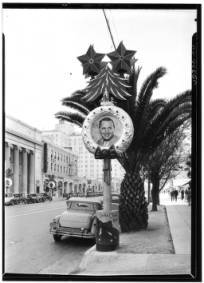 Hollywood Boulevard.
Hollywood Boulevard.Along Hollywood Boulevard, seasonally re-christened Santa Claus Boulevard, streetlight poles sported Christmas trees or medallions with the stars’ faces. The Business Association sponsored a Christmas parade, but it paled in comparison to the New Year’s Day Tournament of Roses Parade in nearby Pasadena.
 Santa Claus Lane.
Santa Claus Lane.Racial segregation characterized the era. African American residents of Los Angeles had a parade of their own on Central Avenue, with a black Santa Claus, and its radio broadcast included a roster of musicians that any organiser would envy, headlined by Louis Armstrong and Fats Waller. Before Christmas, on film sets and in studio dressing rooms, actresses stepped up their knitting, making sweaters and hats for friends and family, while waiting to be called before the cameras. Hedy was a great one for making presents. She modeled miniature animals from clay for her castmates in Come Live with Me.After forming her miniature sculptures, she sent them to a pottery for firing and glazing. Her co-star Jimmy Stewart asked for and received a pig. She also carved doorstops out of wood, and covered them with pieces of her needlepoint that she worked. A metal bootjack in my collection might well have been a Christmas gift from her boyfriend, the similarly artistic Englishman, Reginald Gardiner.
 Hedy Bootjack.
Hedy Bootjack.A box of 21 Christmas cards could be purchased for nineteen cents. A luxurious wool flannel dressing gown, recommended as a present, was priced at $12.95. Newspapers printed many a jewellery shop ad featuring diamond rings, in case a gentleman felt inclined to propose to his sweetheart at Christmas or New Year’s.After the holidays, movie studio publicists worked overtime, reporting on the lavish gifts their stars received. In 1937, Hedy received a ruby bracelet from her Reggie. Another year, Ginger Roger gave her mother a car, and Marlene Dietrich presented her daughter Maria with a convertible. A grateful Sonja Henie gave away her own $25,000 diamond bracelet to her hairdresser. Rita Hayworth presented her friends with perfume. The supposedly stingy Jack Benny sent out cheques to people he worked with. In 1940, Clark Gable and Carole Lombard sent notes to their friends, saying they wanted no gifts, requesting that presents be provided instead to the local children’s hospital.
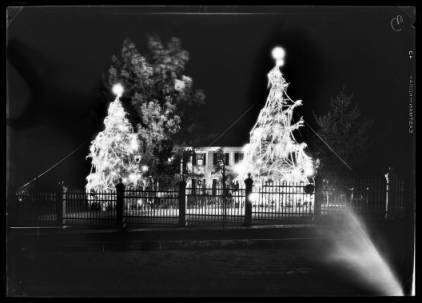 Beverly Hills Christmas Trees.
Beverly Hills Christmas Trees.Candles glowed from the windows of Beverly Hills houses, blinking blue lights were twined through the shrubbery, and brightly lit trees decorated lawns. A favourite accessory was a large and shining blue star over the front door. In 1940, Judy Garland set out lengths of frosted cotton on her window ledges, to resemble real snow. Hedy hung long glass icicles from the gables of her residence. Jeannette Macdonald had “glass ice” strewn upon her lawn to give a wintry impression that the California sun wouldn’t melt. A house in Bel Air sported a “twice life-sized” Santa Claus on the roof, in a sleigh drawn by eight reindeer cutouts.Half of Hollywood, it was reported, stayed at home to entertain visiting relatives from near or far. The other half left town. If seeking snow, they converged upon the mountains in Big Bear Lake or Sun Valley. Those preferring desert warmth ventured to Palm Springs.At the studios, worked stopped promptly at 1 o’clock on Christmas Eve. By lunchtime, the soundstages were turned into party space. Individual departments—scene shop, wardrobe, sound, etc.—held their own separate entertainments, serving eggnog, punch, and home-baked cakes and sweets. The “suits” would drop by to greet their employees. Who usually resumed their labours the day after Christmas.Like Hedy, who routinely sent best wishes to her fans, this author wishes all readers a very happy and festive holiday season!(Photo Credits:Hedy Glamour Shot via Wikimedia; Vintage Hollywood Christmas photos courtesy of University of Southern California. Libraries and the California Historical Society; Bootjack, author’s collection.)
Beautiful InventionBy Margaret Porter

Hollywood Beauty. Brilliant inventor. Hedy Kiesler, Austrian actress of Jewish heritage, scandalizes Europe with her nudity in the art film Ecstasy. Her hasty marriage to a wealthy munitions merchant disintegrates as he grows increasingly controlling and possessive. Even worse—he supplies deadly weapons to Hitler’s regime. She flees husband and homeland for Hollywood, where Louis B. Mayer transforms her into Hedy Lamarr, an icon of exotic glamour. Professional success clashes with her personal life as marriage and motherhood compete with the demands of studio and stardom. Roused to action by the atrocities of World War II, Hedy secretly invents a new technology intended for her adopted country’s defense—and unexpectedly changes the world.One of the Top 12 Hollywood Historical Novels recommended by Bustle.com“Captivating . . . Porter’s insightful account of a gifted yet often misunderstood inventor and movie star makes for a winning novel.” ~ Publishers Weekly“Fast, fun, fascinating, enjoyable, intriguing, and recommended.” ~ Historical Novels Review
Pick up your copy ofBeautiful InventionAmazon UK • Amazon US • Apple iBooks • Kobo• Waterstones• Barnes and Noble
Margaret Porter
MARGARET PORTER is the award-winning and bestselling author of Beautiful Invention: A Novel of Hedy Lamarr and twelve other historical novels. A former stage actress, she also worked professionally in radio, television, and film. Connect with Margaret: Website • Twitter • Instagram • Facebook.
Published on December 12, 2019 19:00
The Coffee Pot Book Club
The Coffee Pot Book Club (formally Myths, Legends, Books, and Coffee Pots) was founded in 2015. Our goal was to create a platform that would help Historical Fiction, Historical Romance and Historical
The Coffee Pot Book Club (formally Myths, Legends, Books, and Coffee Pots) was founded in 2015. Our goal was to create a platform that would help Historical Fiction, Historical Romance and Historical Fantasy authors promote their books and find that sometimes elusive audience. The Coffee Pot Book Club soon became the place for readers to meet new authors (both traditionally published and independently) and discover their fabulous books.
...more
...more
- Mary Anne Yarde's profile
- 159 followers



